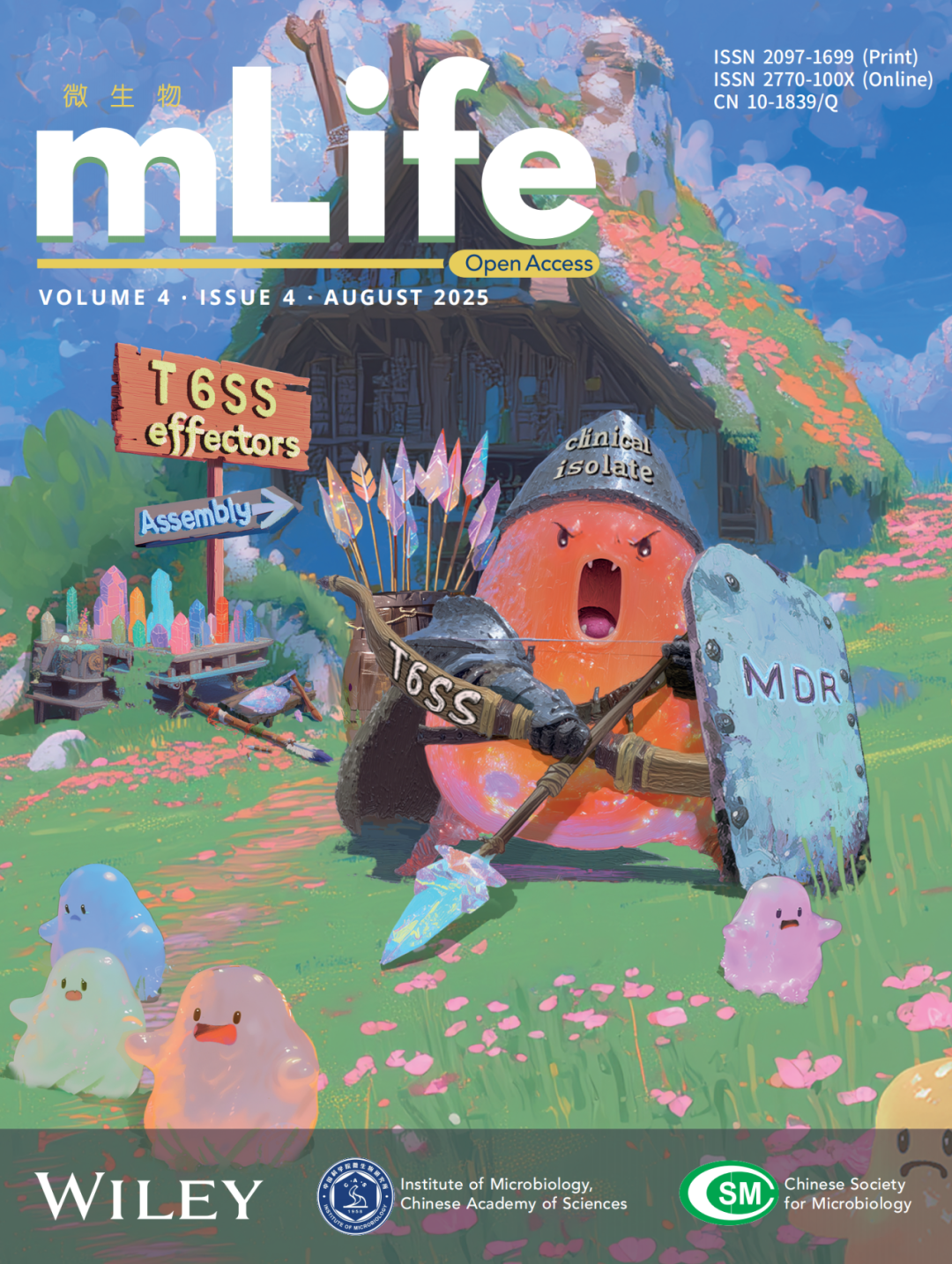 精选
精选

mLife · Volume 4 · Issue 4
于2025年8月31日正式出版

好文速览

扫码或点击文末左下角阅读本期原文https://onlinelibrary.wiley.com/toc/2770100x/2025/4/4
第四卷Issue 4共发表Review 1篇,Original Research 7篇,Correspondence 2篇。本期作者分布在中国、法国、韩国、阿根廷、美国、委内瑞拉、澳大利亚等国家。
Review
▶ Extensive lateral gene transfer between proto-eukaryotes and Heimdallarchaeia suggests their close association during eukaryogenesis
Patrick Forterre

https://doi.org/10.1002/mlf2.70030
The author discusses the phylogeny of Asgard archaea and the hyperthermophilic nature of their last common ancestor. The patchy localization of Eukarya in individual trees relative to Hodarchaeales and other Heimdallarchaeia, as well as the patchy distribution of eukaryotic signature proteins among Asgard archaea, is best explained by suggesting that multiple gene transfers take place between proto-eukaryotes and Asgard archaea in both directions. This review suggests that the co-evolution of proto-eukaryotes and Asgard archaea has played a major role in eukaryogenesis but also in shaping the physiology and diversification of Asgard archaea.
Original Research
▶ Mechanistic insights into the T6SS of multi-drug-resistant Aeromonas hydrophila and its role in competition and pathogenesis
Hao Wang, Ying Liu, Zhao Wang, PeiYi Xia, Zhiwei Li, Ming Liu, Yang Fu

https://doi.org/10.1002/mlf2.70018
The work uncovered a unique genetic architecture of T6SS in the drug-resistant strain AH54, revealing two homologous auxiliary clusters that encode four distinct effector proteins with potent activity against both prokaryotic and eukaryotic competitors. Notably, the Rhs2 effector shows dual-target metal-dependent DNase activity, providing a mechanism for resistance against eukaryotic predation.
The global genomic landscape of hypervirulent Klebsiella pneumoniae from 1932 to 2021
Xiaoyuan Jiang, Shuangshuang Li, Cuidan Li, Zhe Yin, Fangzhou Chen, Lingfei Hu, Tianyu Lu, Xiaoqiang Liu, Yinyu Wang, Guannan Ma, Xiaoyu Wang, Fei Chen, Dongsheng Zhou

https://doi.org/10.1002/mlf2.70029
The study provides the most comprehensive genomic analysis of hvKp, examining 2097 global samples collected over 90 years.The authors identified six major clonal groups (CGs), and performed an in-depth analysis of their virulence determinants, including virulence genes, plasmids, ICEKp, Tn7399, and all_island. The results uncovered strong genomic associations and co-evolution between CGs and these determinants. Notably, one-third of the strains were resistant to carbapenem antibiotics, posing serious treatment challenges.
▶ A butyrate-producing synbiotic mitigates intestinal inflammation in a murine colitis model
Hyuna Sung, Soo Yoon Cho, Seong Hyeok Ma, Jin Sun You, Mi Young Yoon, Sang Sun Yoon

https://doi.org/10.1002/mlf2.70027
The work introduces an innovative synbiotic approach utilizing Bacillus subtilis BM107 and tributyrin (TB) to address unmet needs in inflammatory bowel disease (IBD) management. Unlike existing therapies, this strategy leverages BM107's enzymatic properties to enable targeted butyrate production in the gut, bypassing the challenges of direct supplementation. Beyond demonstrating efficacy in reducing inflammation and restoring gut microbiome balance, the study provides a scalable model for integrating microbial therapeutics with metabolic substrates.
▶ Neutralizing antibodies in the intestinal mucosa are essential to control gastrointestinal infection by Shiga toxin-producing Escherichia coli
Alan Mauro Bernal, Fernando Nicolás Sosa, Yina María Carpintero-Polanco, Camila Dara Cancino, Romina Jimena Fernández-Brando, María Victoria Ramos, Ariel Podhozer, Agustina Errea, Martín Rumbo, Marina Sandra Palermo

https://doi.org/10.1002/mlf2.70026
The work demonstrated that systemic and/or local anti-STEC antibodies, capable of recognizing specifically STEC O157:H7, can impair STEC motility and adhesion to intestinal epithelial cells. Thus, this study provides insight into the protective role that specific antibodies play in the prevention of systemic diseases secondary to STEC infections, providing new therapeutic options.
▶ The antibacterial effect of tellurite is achieved through intracellular acidification and magnesium disruption
Wanli Peng, Yali Fu, Yanqiu Wang, Zixin Deng, Daijie Chen, Shuangjun Lin, Rubing Liang

https://doi.org/10.1002/mlf2.70028
The work discloses how tellurite, an age-old yet potent antimicrobial, disrupts bacterial survival by disturbing the balance of protons and magnesium. This imbalance impedes protein production and weakens bacterial metabolism. Significantly, trace amounts of tellurite markedly enhance the efficacy of existing antibiotics, even against drug-resistant strains.
▶ Regulation of filamentous phage Pf4 activation by oxidative stress in Pseudomonas aeruginosa
Zixian Huang, Xinqiao Zhang, Shituan Lin, Jiayu Gu, Cong Liu, Mingzhang Wen, Yunxue Guo

https://doi.org/10.1002/mlf2.70031
Filamentous Pfs in P. aeruginosa are pivotal for biofilm formation, virulence, antibiotic resistance, and evolution of host cells, and they also mediate horizontal gene transfer among different strains. In this study, the authors revealed that oxidative stress stimulates Pf4 activation through OxyR binding to the promoter region of its excisionase gene xisF4. This work elucidates the interplay between genetic components and environmental stressors in coordinating Pf4 activation.
▶ Conserved mycobacterial sRNA B11 regulates lipooligosaccharide synthesis at posttranscriptional level in Mycobacterium marinum
Chuan Wang, Cheng Bei, Yufeng Fan, Qingyun Liu, Yue Ding, Howard E. Takiff, Qian Gao

https://doi.org/10.1002/mlf2.70025
Despite the identification of mycobacterial sRNAs over a decade ago, their functions and regulatory mechanisms have remained largely unexplored. This study presents a comprehensive analysis of mycobacterial sRNAs, utilizing robust experimental approaches to identify key target genes. This work demonstrates how the conserved sRNA B11 regulates the synthesis of lipooligosaccharides (LOSs), crucial components for environmental stress response and host immune modulation.
Correspondence
▶ Not too rigid nor too wobbly: Defining an optimal membrane fluidity range essential for biofilm formation in Escherichia coli
Yaoqin Hong, Jilong Qin, Makrina Totsika

https://doi.org/10.1002/mlf2.70024
Membrane fluidity plays a crucial role in bacterial fitness and adaptation to cope with rapid environmental changes. The study demonstrated that both low and high extremes of lipid fluidity restrict biofilm formation. The authors propose that the required fluidity for biofilm growth, relative to that required for planktonic growth, may differ between species and is readily adjusted to fall within a “Goldilocks” range during lifestyle transitions.
▶ Metatranscriptome profile of agricultural microbial communities enriched for plastitrophy
Fatai A. Olabemiwo, Yuting Huang, Macy Thompson, Hanan Omar, Siddhant Kalra, Philip Arevalo, Valerie Nazzaro, Frederick M. Cohan

https://doi.org/10.1002/mlf2.70023
This work identified 192 genes specifically upregulated in low-density polyethylene (LDPE) conditions, including 10 genes encoding known plastizymes and 182 genes encoding putative plastic-degrading enzymes. Detailed enzyme classification revealed predominant roles for oxygenases (20%) and dehydrogenases (19%), with specific subclasses showing distinct distribution patterns.
mLife
期刊简介
mLife是由中国科学院主管、中国科学院微生物研究所主办(中国微生物学会为合作单位)的我国微生物学领域第一本综合性高起点英文期刊。mLife瞄准全球微生物学领域高水平科研成果和前沿进展,报道内容覆盖微生物学各个学科。mLife的办刊目标是打造微生物学领域综合性国际旗舰期刊。目前,mLife已被国内外重要数据库ESCI、PubMed Central、Scopus、CSCD、DOAJ、CAS等收录。mLife 2024年度JCR影响因子为4.5,位于微生物学科Q1区。2025年,mLife入选中国科学院期刊分区表生物学二区。
期刊网站:
https://wileyonlinelibrary.com/journal/mLife
https://www.sciopen.com/journal/2097-1699
投稿网站:https://mc.manuscriptcentral.com/mlife
转载本文请联系原作者获取授权,同时请注明本文来自SciOpen TUP科学网博客。
链接地址:https://wap.sciencenet.cn/blog-3563286-1500383.html?mobile=1
收藏

